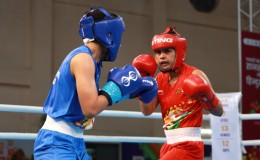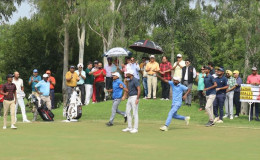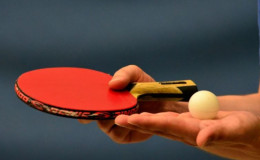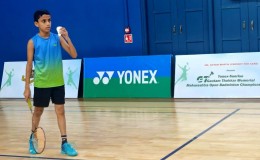
Gymnastics is a kind of exercises developing or showing physical agility and coordination.
The modern sport of gymnastics typically involves exercises on uneven bars, balance beam, floor, and vaulting horse, and horizontal and parallel bars, rings, floor, and pommel horse.
It evolved from exercises used by the ancient Greeks and from circus performing skills.
Forms and types of gymnastics:-
Artistic gymnastics:
Artistic gymnastics is usually divided into Men''s and Women''s Gymnastics.
Typically men competes six events: Floor Exercise, Pommel Horse, Still Rings, Vault, Parallel Bars, and High Bar.
Women compete four: Vault, Uneven Bars, Balance Beam, and Floor Exercise.
Rhythmic gymnastics:
Only women compete in rhythmic gymnastics although there is a new version of this discipline for men being pioneered in Japan.
The sport involves the performance of five separate routines with the use of five apparatus—ball, ribbon, hoop, clubs, rope—on a floor area, with a much greater emphasis on the aesthetic rather than the acrobatic.
Trampolining and Tumbling:
Trampolining and tumbling consists of four events, individual, synchronized, double mini and power tumbling.
Since 2000, individual trampoline has been included in the Olympic Games. Individual routines in trampolining involve a build-up phase during which the gymnast jumps repeatedly to achieve height, followed by a sequence of ten leaps without pauses during which the gymnast performs a sequence of aerial skills.
Acrobatics gymnastics:
Acrobatic gymnastics (formerly Sports Acrobatics) often referred to as acro is a group gymnastic discipline for both men and women.
Acrobats in groups of two, three and four perform routines with the heads, hands and feet of their partners.
These are performed at three FIG levels: Age group (Age 11-16), Junior(12-19) and Senior (15+), which are used in the World Championships and many other events around the world, including European Championships and World Games.
Team Gym
Team Gym or Gymnastics for All has its origins in earliest times.
In 1984 Gymnastics for All was officially recognized first as a Sport Program by the FIG (International Gymnastic Federation), and subsequently by national gymnastic federations worldwide with participants that now number 30 million.
Floor Programme
All members of the Team take part in the floor program, composed of a mixture of dance, flexibility and skill.
The routine has to be skillfully choreographed and the judges look out for changes in shape.
There needs to be at least two spins, two balances and two section elements.
These section elements are body waves for women''s teams, power elements for men''s teams and lifts for mixed teams. Floor routines are performed to music.
Display gymnastics:
General gymnastics enables people of all ages and abilities to participate in performance groups of 6 to more than 150 athletes.
They perform synchronized, choreographed routines.
Troupes may be all one gender or mixed.
There are no age divisions in general gymnastics.
Aerobic gymnastics:
Aerobic gymnastics (formally Sport Aerobics) involves the performance of routines by individuals, pairs, trios or groups up to 6 people, emphasizing strength, flexibility, and aerobic fitness rather than acrobatic or balance skills.
Routines are performed for all individuals on a 7x7m floor and also for 12–14 and 15–17 trios and mixed pairs.
From 2009, all senior trios and mixed pairs were required to be on the larger floor (10x10m)
Routines generally last 60–90 seconds depending on age of participant and routine category
Some other form of Gymnastics:
Rope (Rhythmic gymnastics)
Rope climb &
Flying rings
General Rules of Gymnastics:
Only one attempt is allowed on each piece of apparatus.
Each gymnast may devise their own routines but certain criteria must be met to meet required skill factors.
''Spotters'' may stand next to complex equipment such as the bars to prevent injury.
In case help is required by the gymnast a penalty of 0.4 is taken from the final score, although they are allowed help into their starting positions for the rings and horizontal bars.
Difficulty judges confer after an exercise and give the routine a mark out of 10.
Execution judges rate each performance in terms of form and skill.
They give a mark out of ten, deducting fractions of points for errors. Minor errors cost 0.1 of a point; more serious errors cost see a deduction of 0.2, 0.3 or 0.4 of a point.
If a gymnast falls from equipment half a point is deducted.
The highest and lowest scores awarded by the judges are discarded and the remaining scores are averaged to give the gymnast an overall mark.
Permission must be obtained before a gymnast can leave the arena
An exercise may not be repeated unless the gymnast has been interrupted through no fault of their own.
Unsporting behavior incurs a judge''s penalty.
Bandages and leather grips may be used by contestants
Governing bodies:
Internationally it is governed by Federation Internationale de Gymnastique (FIG)
Prof. Bruno Grandi is the current president.
Apart from that each nation has its own governing body, affiliated from FIG.
Gymnastics Federation of India (GFI) is the body looking after gymnastics in India.
It is currently headed by Mr Suidhir Mital as President and Mr Kan Singh Rathore as secretary general and a team of dedicated persons to manage and administer the gymnastic activities in India.










